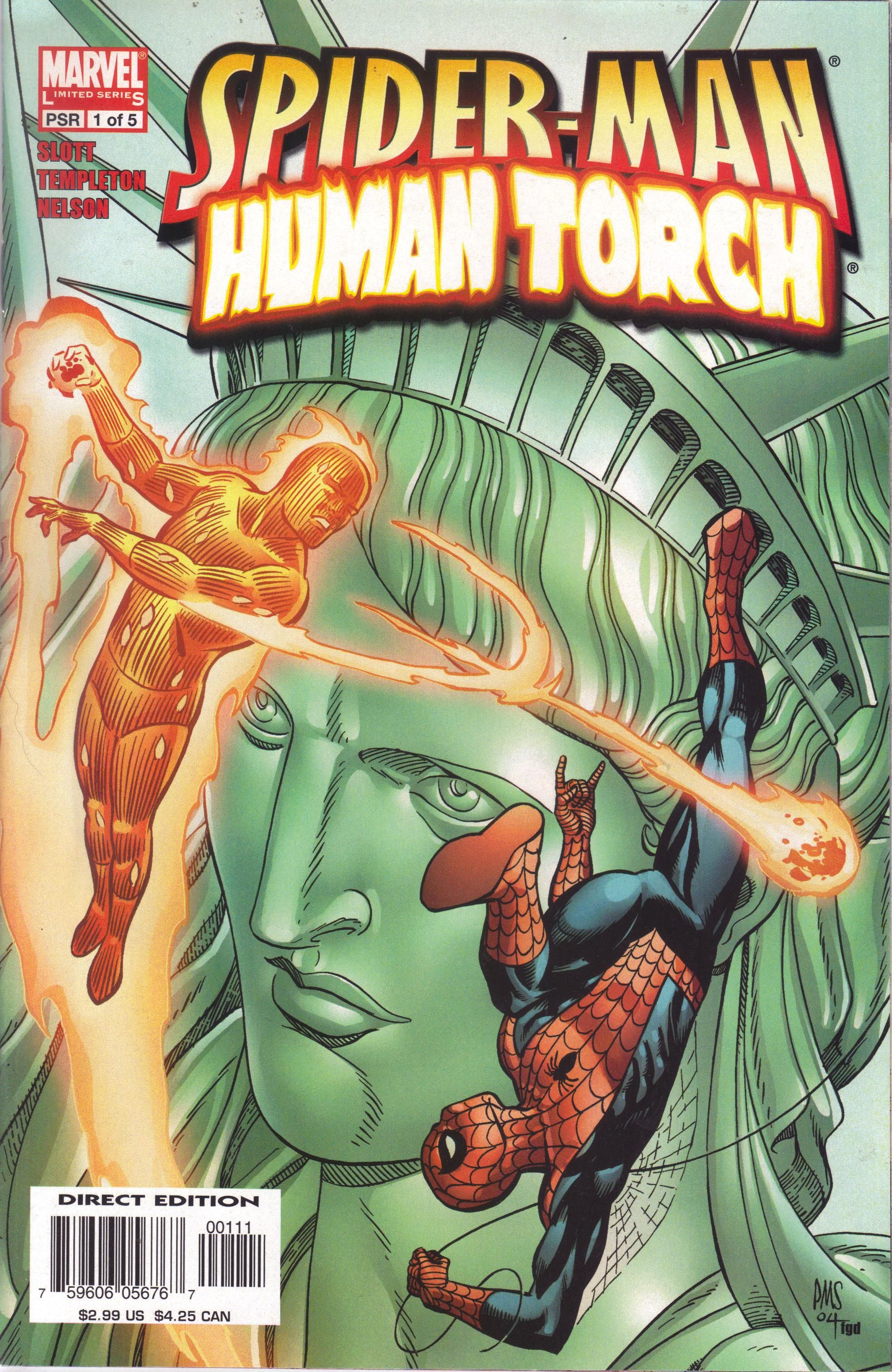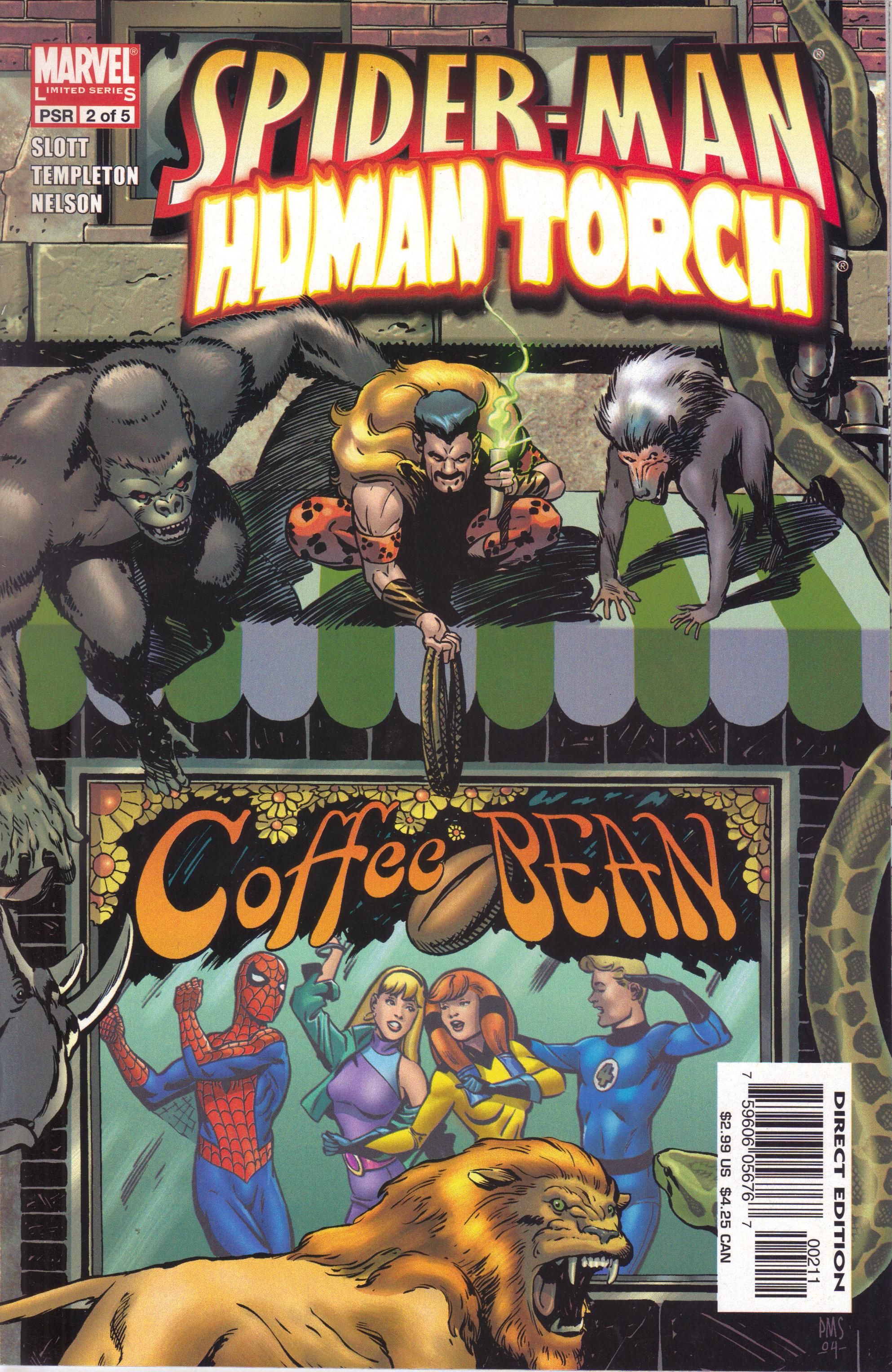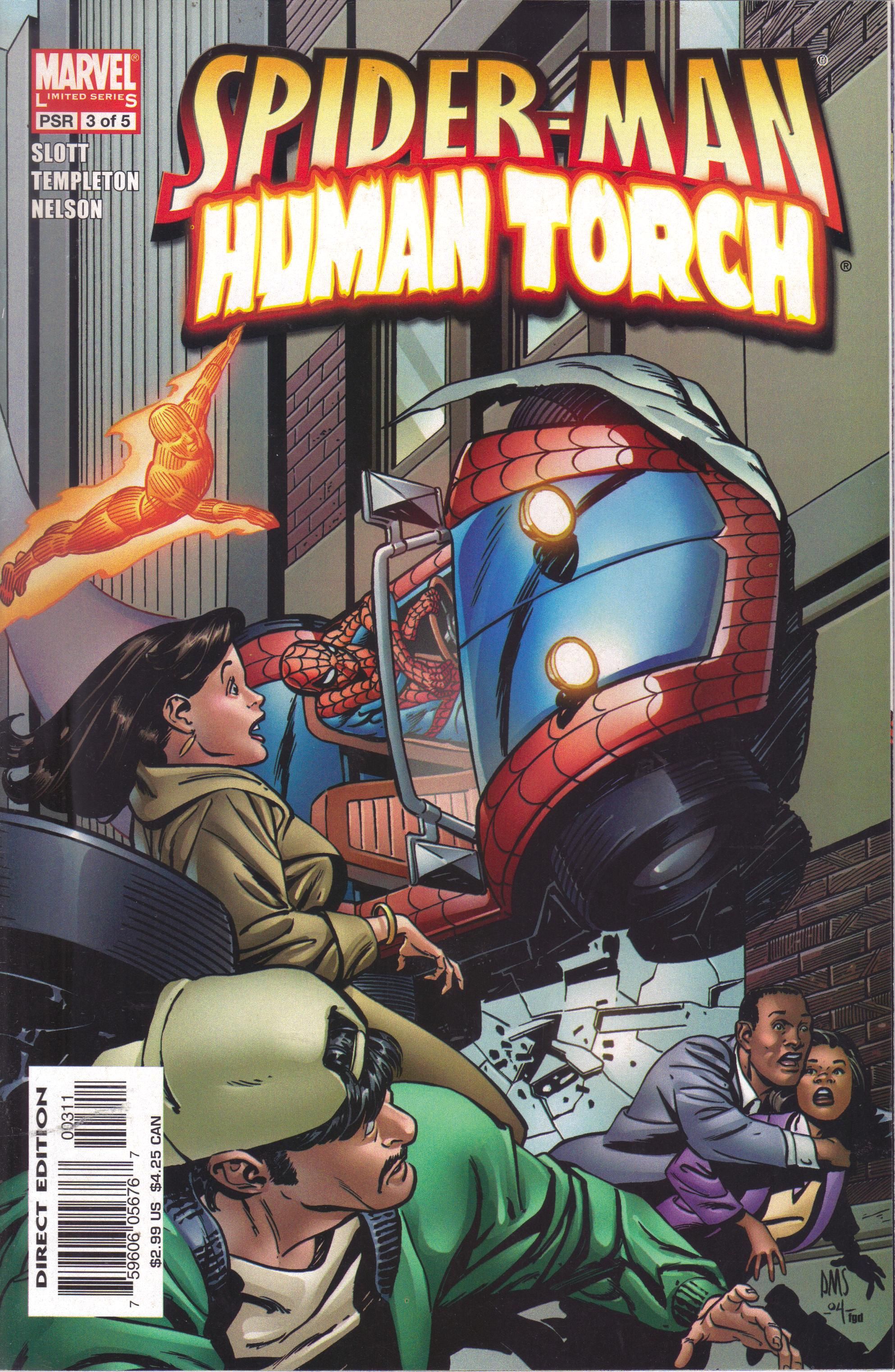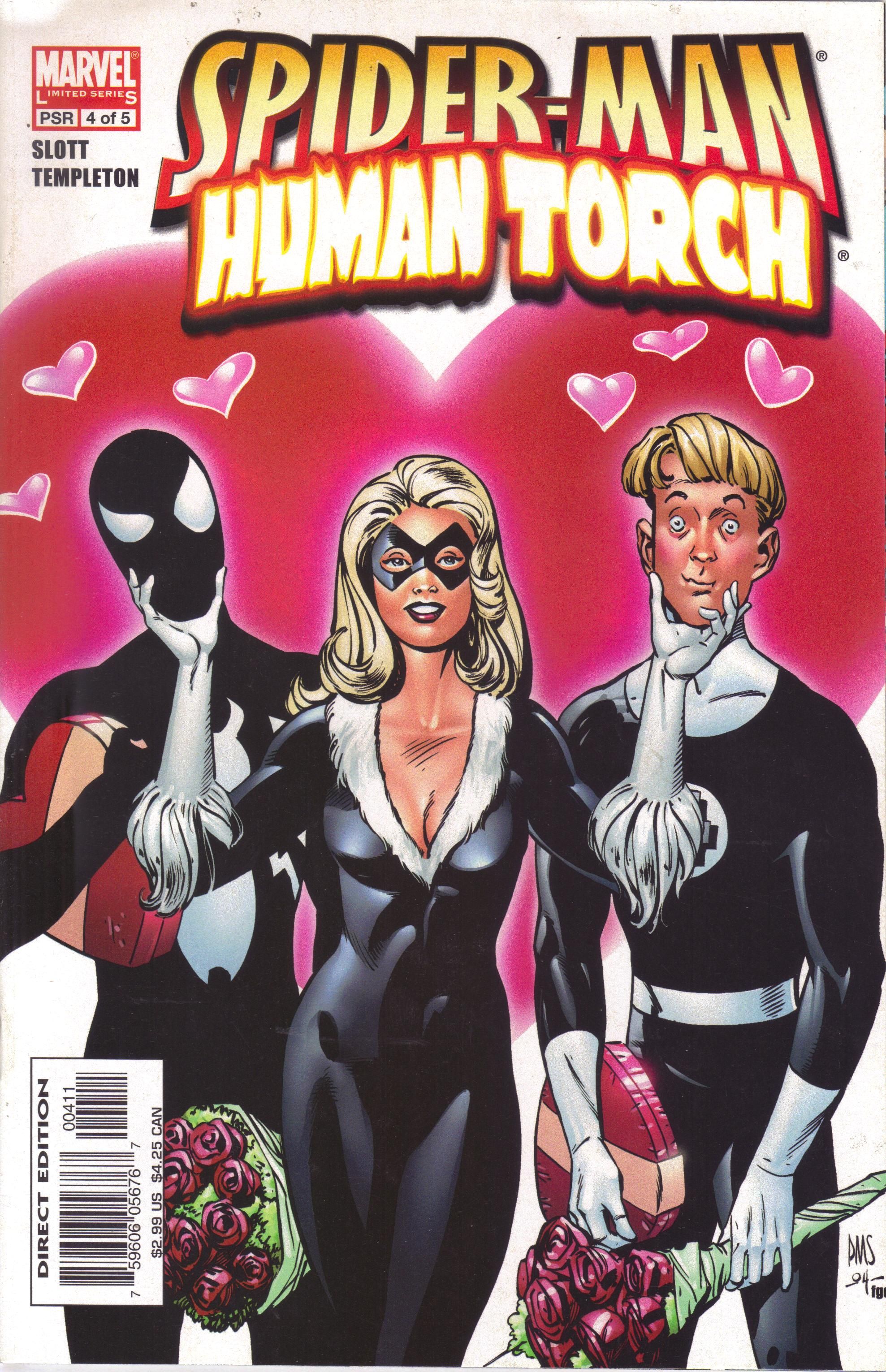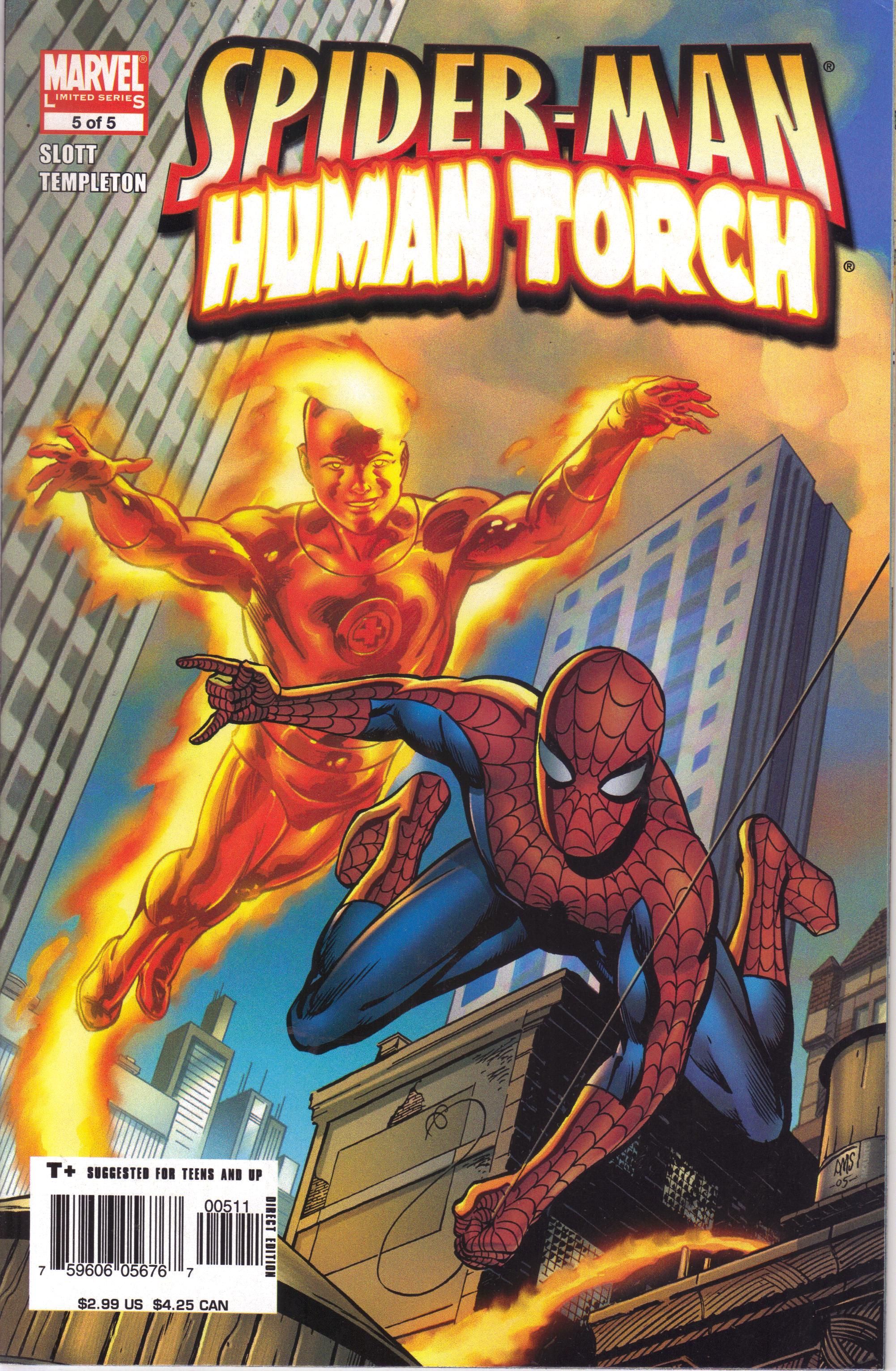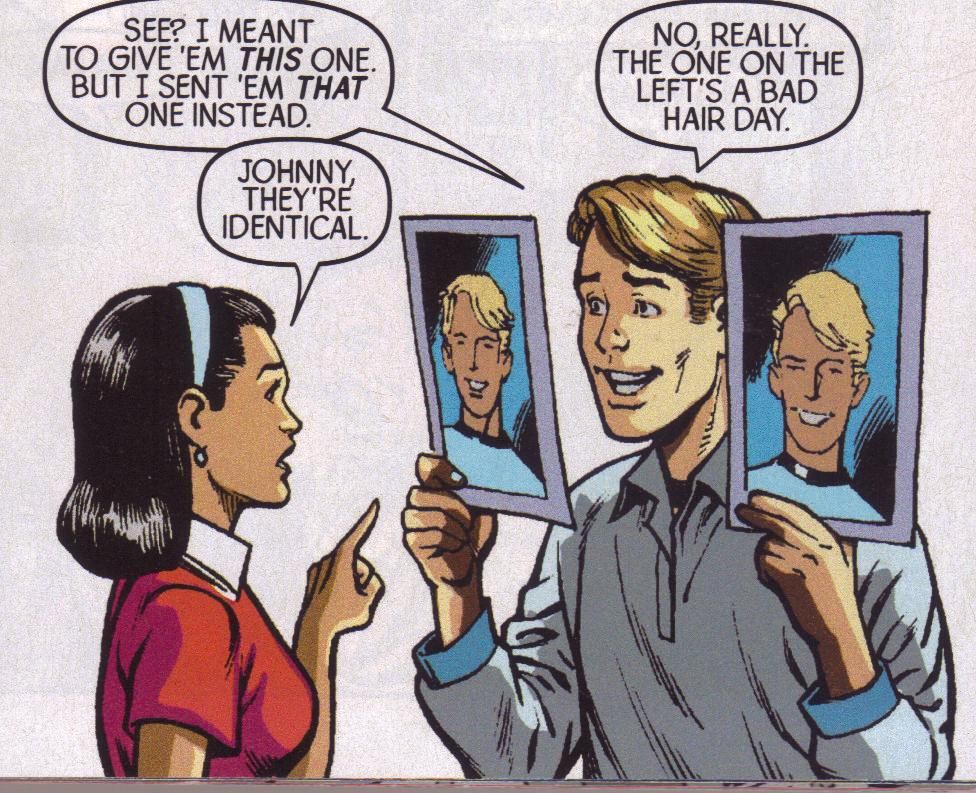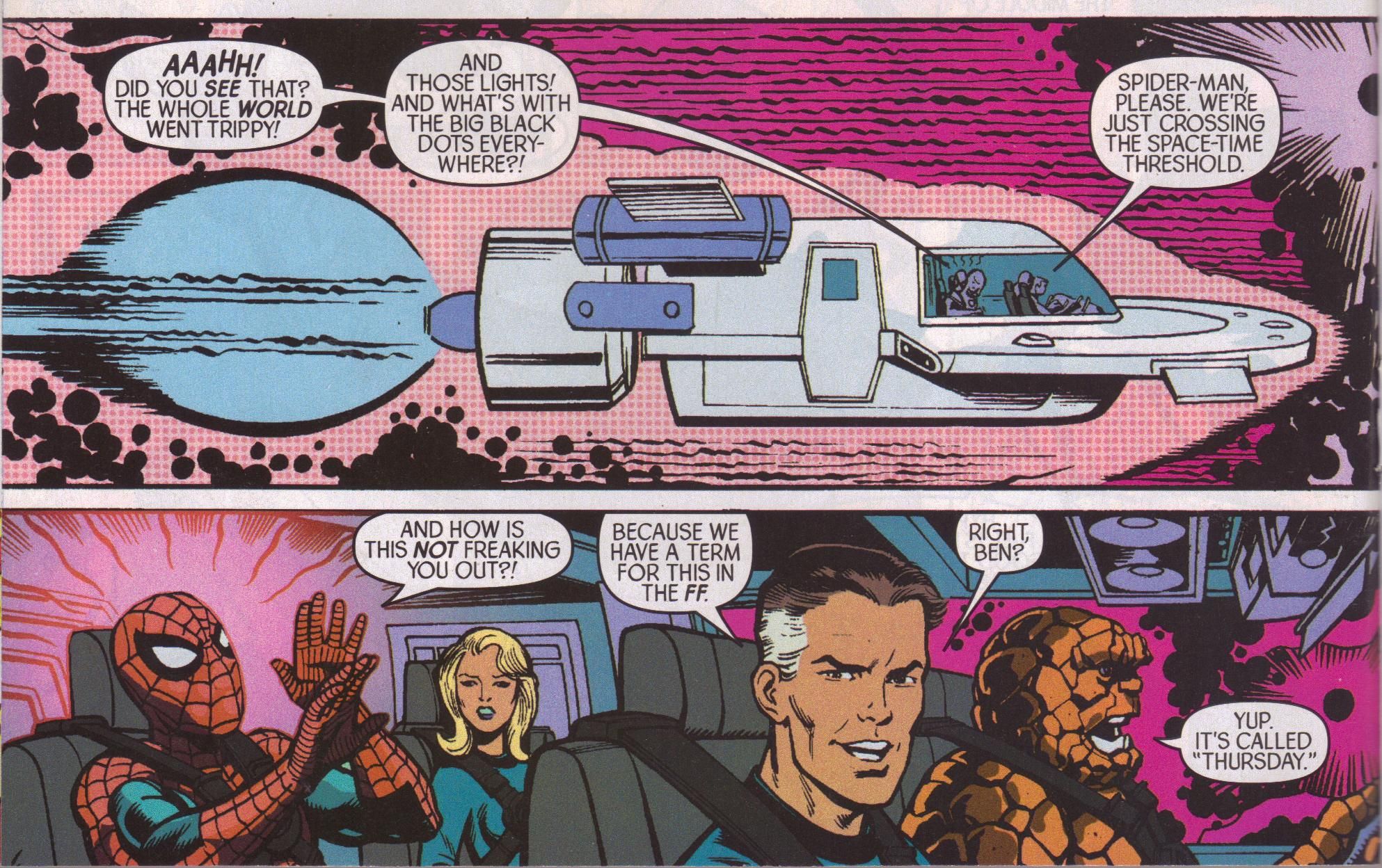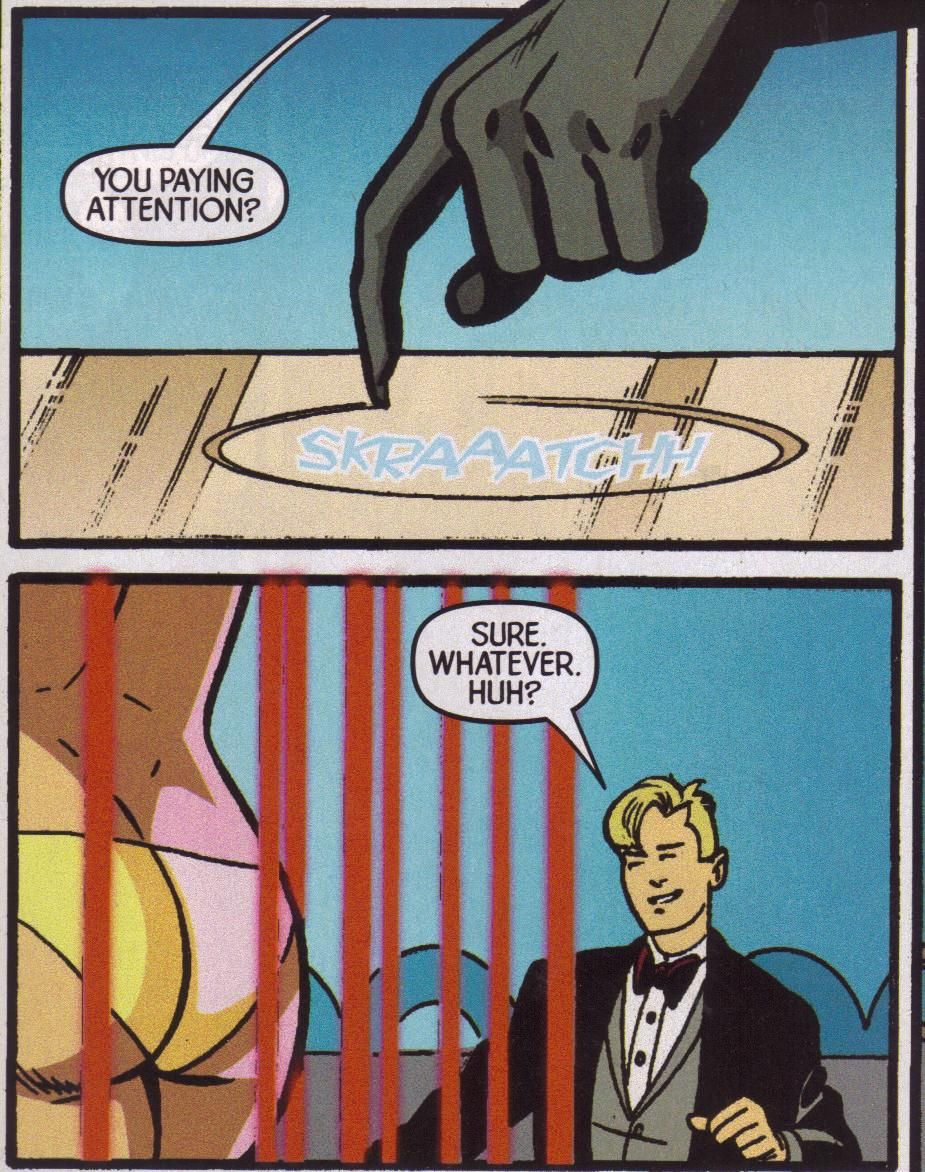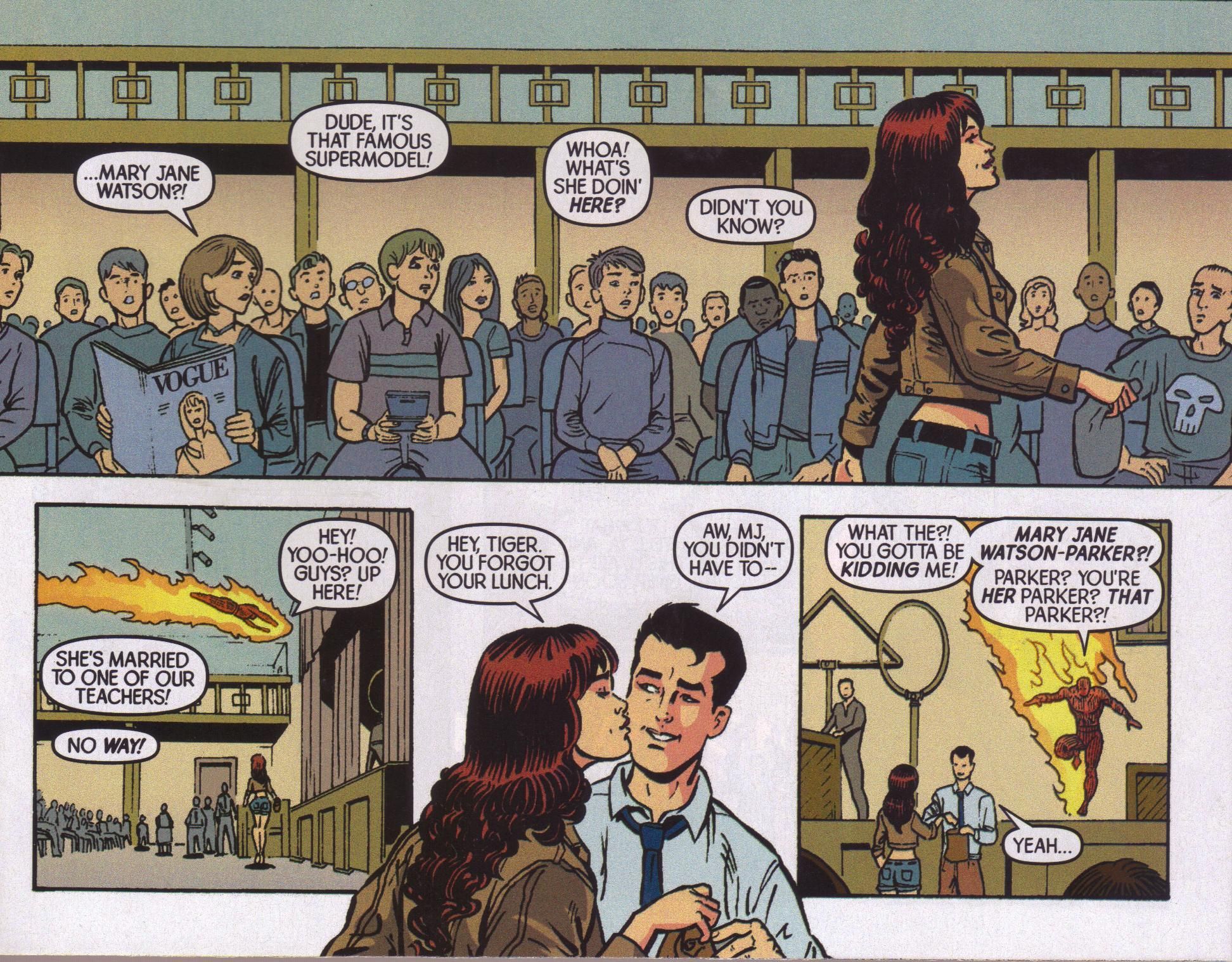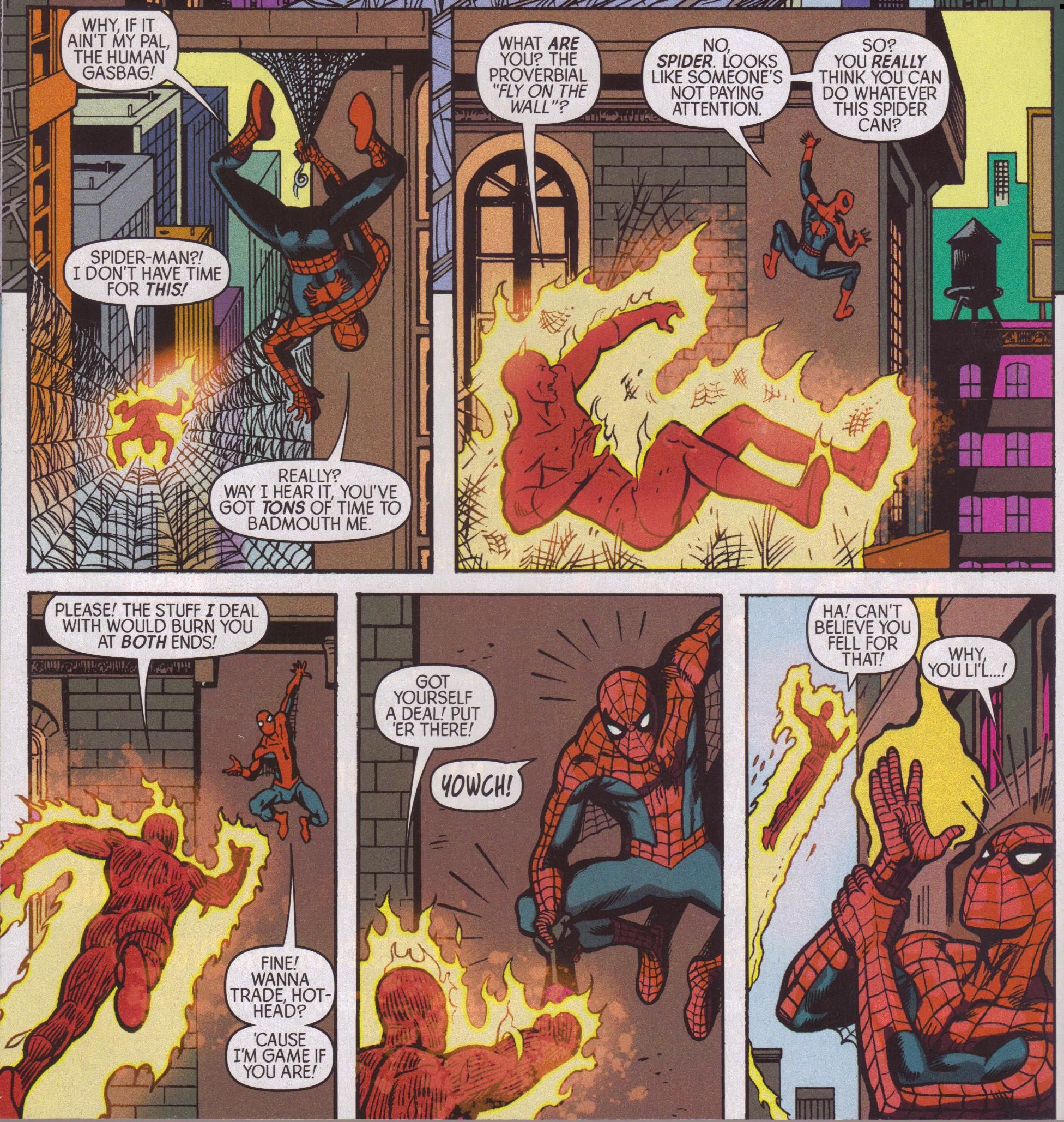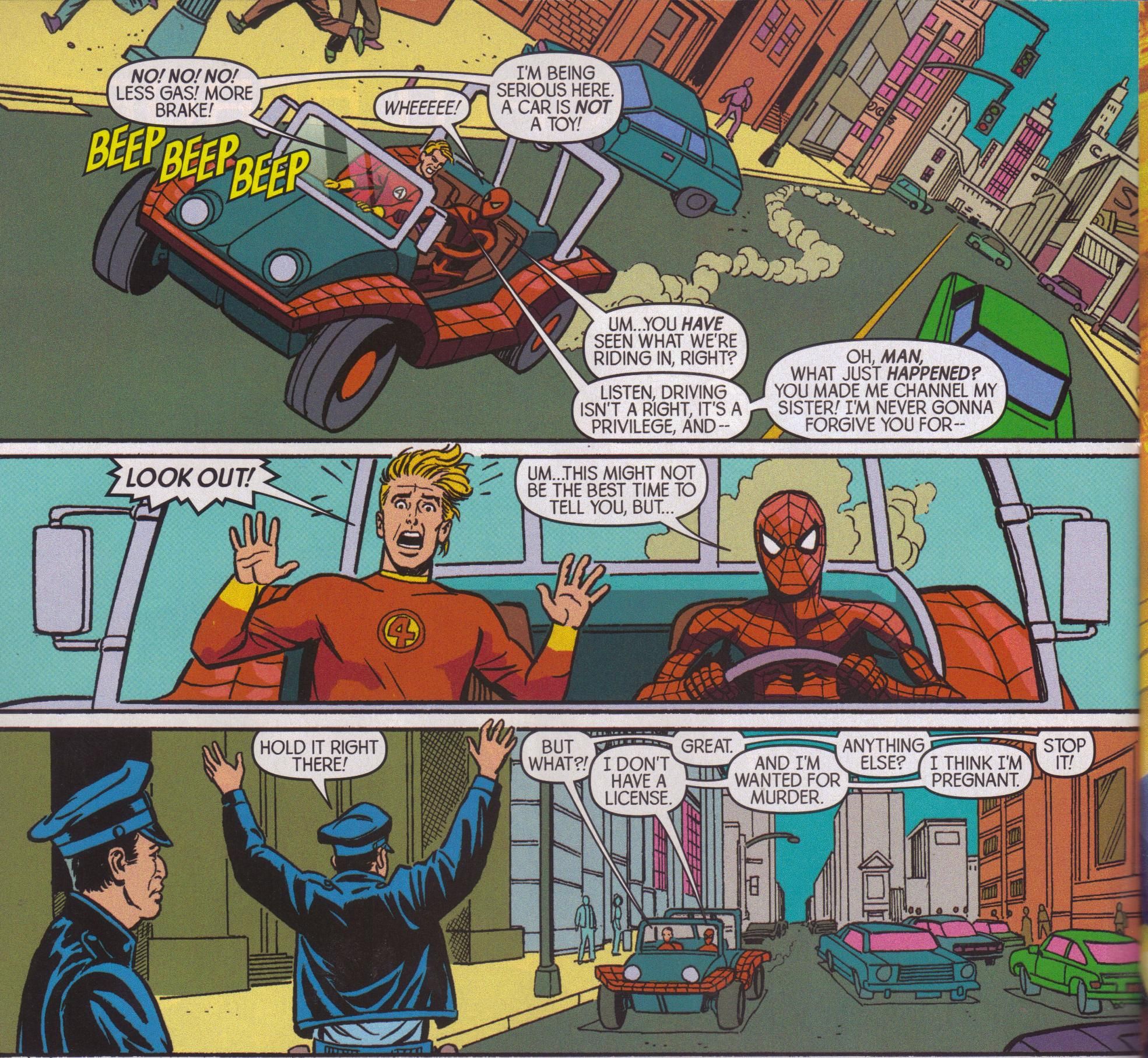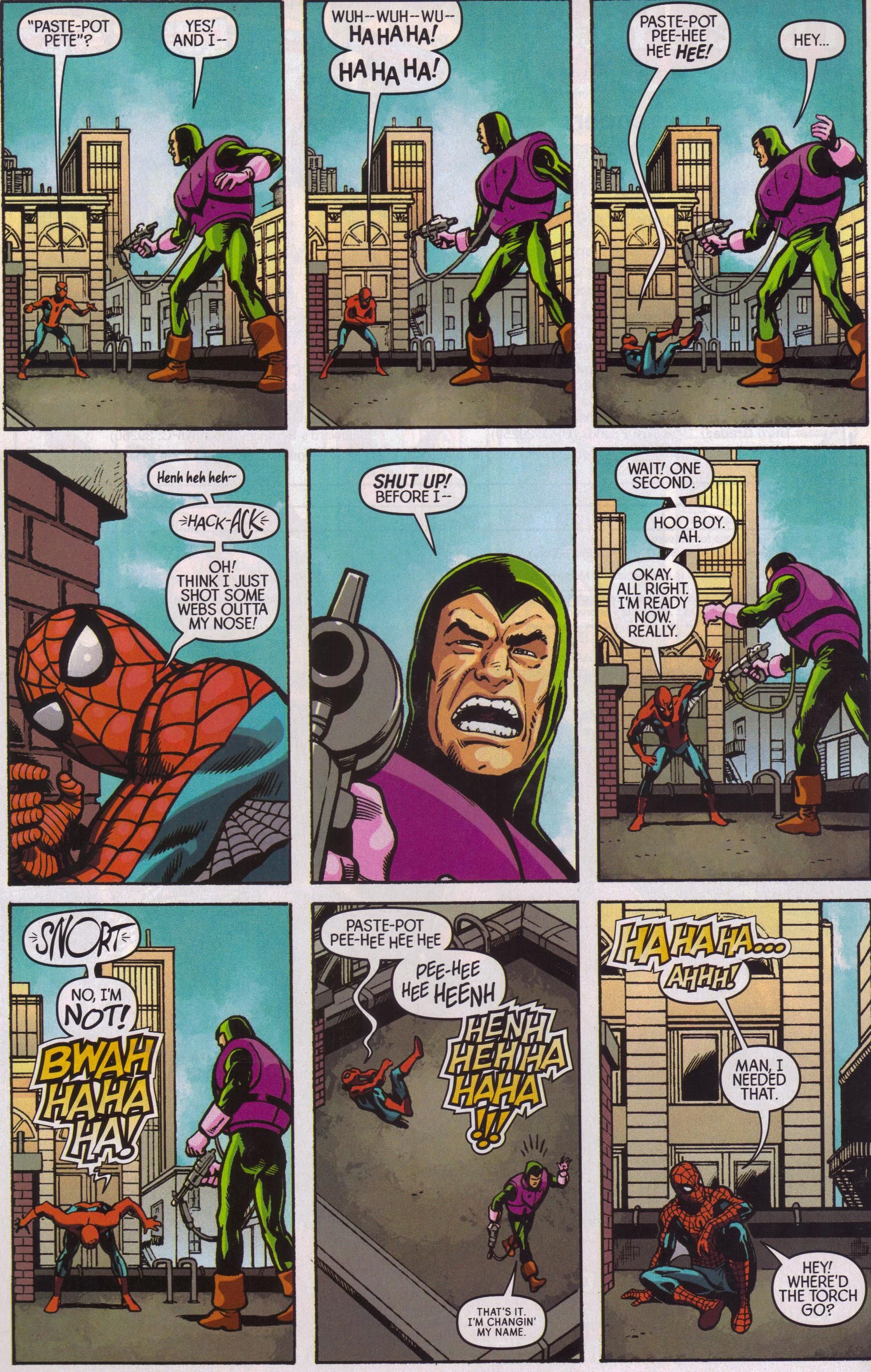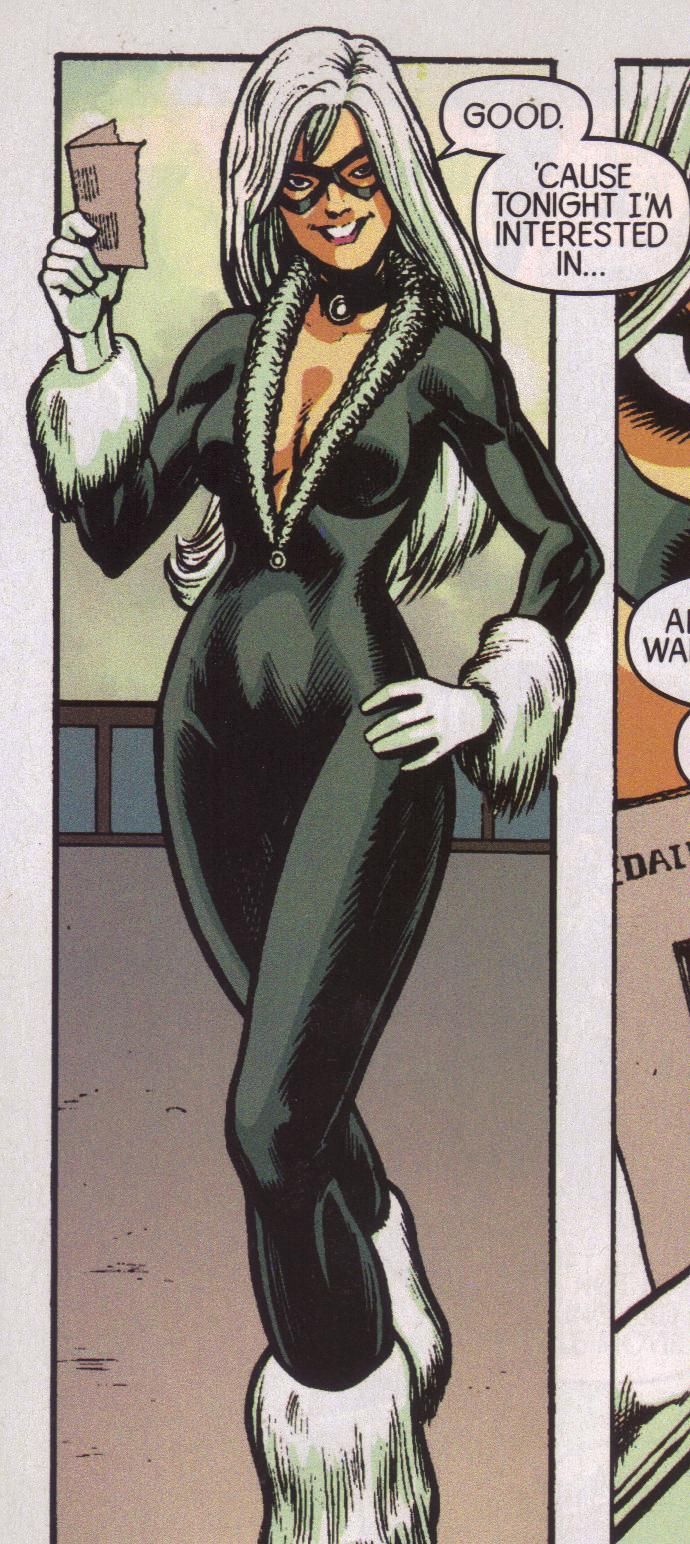More comics from that wacky Dan Slott!
Spider-Man/Human Torch by Dan Slott (writer), Ty Templeton (penciler), Nelson (inker, issues #1-3), Tom Palmer (inker, issues #2-4), Drew Geraci (inker, issues #4-5), Greg Adams (inker, issue #5), Felix Serrano (colorist, issues #1-3), John Rauch (colorist, issues #4-5), and Dave Lanphear (letterer).
Published by Marvel, 5 issues (#1-5), cover dated March - July 2005.
Very minor SPOILERS below - this isn't really a comic that can be spoiled, and I don't get too into it, but there's a tiny bit of it. I shouldn't worry, though.
Continuity has become a dirty word in comics, from people who claim that writers ignore it too much to people who say that no one should be beholden to it.
It's one of the more charming things about mainstream superhero comics, however - the idea that no matter who is writing the characters, they're the same people who have experienced everything that has ever been published. It becomes tangled, of course, and messy, but one of the "inside" pleasures of reading DC and Marvel comics is when you realize a writer is referencing stories that you might have read a decade or more earlier. As the characters' histories get longer, continuity becomes messier and messier, and it's not a bad thing to free the writers from it, but for long-time fans of comics, it can add some fun to the reading experience.
Dan Slott is one writer who seems to enjoy continuity and is fairly decent about using it, and it makes this mini-series a pleasure to read. Some of these Comics You Should Own are for anyone - people who have never read a comic can pick them up and, I hope, enjoy them. Spider-Man/Human Torch is not one of those comics.
That's not to say that if you've never read a comic before, you will hate the book. But it's steeped in a history that is closely linked to Marvel history, as it tracks a friendship over the many years of the Marvel Universe. I'm certainly not going to say you can't like it if you don't know anything about Marvel history, but I imagine it's much, much better if you do know a good amount about it.
What also makes this such a good story is that it's about the friendship of two characters in the mainstream Marvel Universe, which is, unfortunately, somewhat in short supply these days. Have you ever noticed that not many characters in the mainstream superhero universes seem to like each other all that much? And if they do, they don't seem to, you know, just hang out with each other? It happens, certainly, but not as often as it should (in my humble opinion), and while Slott doesn't write five issues of Peter Parker/Spider-Man hanging out with Johnny Storm/Human Torch, he does show us the evolution of their friendship from a quasi-rivalry to a more complex relationship. While this is one of those strengths of a shared universe - the idea that characters' relationships can evolve over decades - Slott telescopes that into five issues, but he's a good enough writer that he's able to get to the crucial stages of their relationship without making it feel forced or rushed.
Along the way, he drops in some nice continuity touches (Peter is the one who makes Paste-Pot Pete change his name to the Trapster, for instance) and some retcons that don't contradict anything (Captain Stacy is much more obvious about knowing Peter's secret than he ever was in the "real" series, at least as far as I can remember), all while telling entertaining superhero stories. The focus isn't the superhero stuff, but he gets in quite a lot of it.
Peter and Johnny teamed up a lot in the 1970s, which is where the basis for their friendship comes from. Over the years, other writers have built on that, and Slott uses that to go back to their early days and show how they developed. He tells self-contained stories from different eras, but each story adds a bit to the ultimate conclusion, which is that the two men don't really understand each other. Peter and Johnny envy the other, for the same reasons that they think their own lives aren't too great. So in issue #1, Johnny hires Peter to be his photographer, but when he doesn't do anything noteworthy for Peter to take pictures of, he decides to go after Doctor Doom, with predictably bad results. Peter gets him out of the pickle, but at the cost of his own (already damaged) reputation. In issue #2, Johnny, who's standing right next to his hot girlfriend Crystal, thinks about how Peter is lucky because Gwen and Mary Jane are fighting over him. Meanwhile, Johnny lets Flash Thompson goad him into making a "trade" with Peter - the Torch will go around fighting street crime, while Spidey will join the Fantastic Four on one of their weird journeys. It doesn't go well for either of them early on, but Johnny recovers and becomes a hero in the city, while Peter is shown the door by the rest of the FF.
In issue #3, Peter gets an internship with Reed Richards, but because he "shares" the access codes to Reed's lab with "Spider-Man," Reed fires him. Johnny helps out the Black Cat in issue #4 while Peter believes she's stealing things again, but in the end, Spidey and Felicia end up making out. Finally, in issue #5, Peter is forced to reveal his secret identity to Johnny, which brings out their jealousy of the other. Slott does a nice job keeping things light even as they move into some more emotional areas - the book is essentially a comedy, but it's nice that the two men acknowledge that they've had some issues with each other over the years. The fact that Johnny now knows Peter's identity (even though many others found out first, including Reed) allows their friendship to be more out in the open, without all the cases of "mistaken" identity, like when Felicia was kissing Spider-Man and making Johnny mad, because he knew she was dating Peter.
Slott, as I noted, gets to the black heart of a lot of current superhero comics - the lack of meaningful friendships.
When Chris Claremont was building the X-Men into a sales powerhouse, the idea of superheroes fighting each other at the drop of a hat became more of a cliché and the idea of them being friends became more accepted, and during this era at Marvel, it became more common for superheroes from different books to actually be friendly with each other. This even bled over into DC. During the "grim-'n'-gritty" era, that kind of comics universe started to fall out of fashion, and everyone became angry again. In 2005, that attitude still prevailed, even in team books, where characters often tolerated each other for as long as it took for one of them to leave a toilet seat up, which would spark a multi-issue war to end all wars. Slott bucked that trend in this comic, as nothing Spider-Man and the Torch get into is all that serious, even the Doctor Doom scene, so that the superhero part is not terribly dramatic. It's exciting, but Slott doesn't go for any histrionics when it comes to the bad guys. They might have some temporary setbacks, and in the final issue, Slott actually injects the tiniest bit of "realism" into the series when bad guys threaten Peter's school, but the action is just a way to move the plot along. Slott writes the two characters very well, but another reason why this is such a refreshing comic is because it stands as an oddity in a superhero world where everyone is always gritting their teeth at each other.
The foundation of the comic is also what makes it a Comic You Should Own, even though the humor is the icing on it all. I don't want to give away all the jokes, but Slott generally nails them. One thing about working with long-standing characters is that you can highlight some of the goofiness of their histories, so of course we get the Spider-Mobile in issue #3.
It's the more subtle humor, however, that stands out, because it flows from the regular conversations that the characters have. In issue #1, Slott makes a joke about Johnny not remembering who Peter is even though they've met before, and it shows how immature Johnny is. The idea of Peter always having attractive women drooling over him is played for humor, as long-time readers know that Peter was always bemoaning his lack of a love life, while Slott shows that he had it better than a lot of people (in the interest of time and space, I guess, Slott ignores the many other women Peter hooked up with - he sticks to Gwen, Mary Jane, and Felicia). Slott makes fun of Peter's parallel parking woes - why would someone who lives in New York and doesn't own a car know how to parallel park? He takes time to set up a Hostess Fruit Pies gag, which has become a cliché but wasn't as much of one (if at all) in 2005, and because Slott takes his time with it and it's actually germane to the story, it lands better. The writing is so crisp that the dialogue flows like a well-written sitcom, which is hard to do in comics. Slott does a very nice job blending in the comedy with the reality of life as a superhero (it's not surprising that he has to have a scene where Peter talks to the dead Gwen Stacy), so that the ending doesn't feel like a "very special episode," but the culmination of a heartfelt journey.
Part of the reason this series feels old-school is because Ty Templeton draws it, and Templeton has a very old-school vibe to it. He's not a flashy artist, but he's a very good storyteller, and he draws the characters very well. When he wants to, he can do some cool things - when Spidey goes off with the Fantastic Four in issue #2, he gives us some nice Kirby Krackle as they zip across dimensions (he does this in issue #3, too). He draws a crowded New York City, which works really well, because Spidey is such a New York hero (the Torch is too, but a bit less so) that it's nice to read a comic that has such a good sense of place. Obviously, as this is a comedic book, his art has to work with Slott's comic timing, and his body language is really nice. When Spidey meets Paste-Pot Pete, Templeton gives us this page of him laughing so hard he falls down:
As the two stars are often angry with each other, Templeton does a good job showing them overreacting to every situation.
He needs to make them look angry in a comedic way, and his smooth line work is perfect for that - even as Johnny and Peter are raging at each other, Templeton's work makes it clear that they're more like friendly rivals or siblings, not people who actually hate each other.
He draws lovely women, too - his She-Hulk in a French maid's outfit is tremendous. What's nice about his women is that he can draw beautiful women without making them too sexualized - even She-Hulk, even Felicia, even Mary Jane in her model days - so that they fit the more universal vibe of the book. This isn't exactly a comic for kids, but it's certainly not something you'd be worried about your kids reading. Templeton keeps the eras in mind - despite the fact that, due to Marvel's sliding time scale, none of this actually takes place in the 1970s or 1980s, he gives Johnny a very 1980s haircut in issue #4, for instance. Gwen and Mary Jane wear their hair in the classic John Romita style in the early issues, while Felicia's hair in issue #4 is a bit longer and wilder. In issue #5, Mary Jane's hair is longer and curlier, showing her status as a super-model. They're subtle differences, but Templeton does really nice work with them. Templeton's art is probably not going to blow anyone away, but in this series, he does a very nice job with the tone that Slott is going for.
Spider-Man/Human Torch is offered in a trade, of course, and it's well worth a read. It's the kind of comic many fans say they want but rarely get - it's both fun and funny, it focuses more on the characters than endless action, and it has a lot of nods to past continuity without being enslaved to it. If Slott and Templeton can do it, why can't others? I guess we'll just have to read this instead!
Don't forget that the archives are big and getting bigger! There's always something fun to find there!


